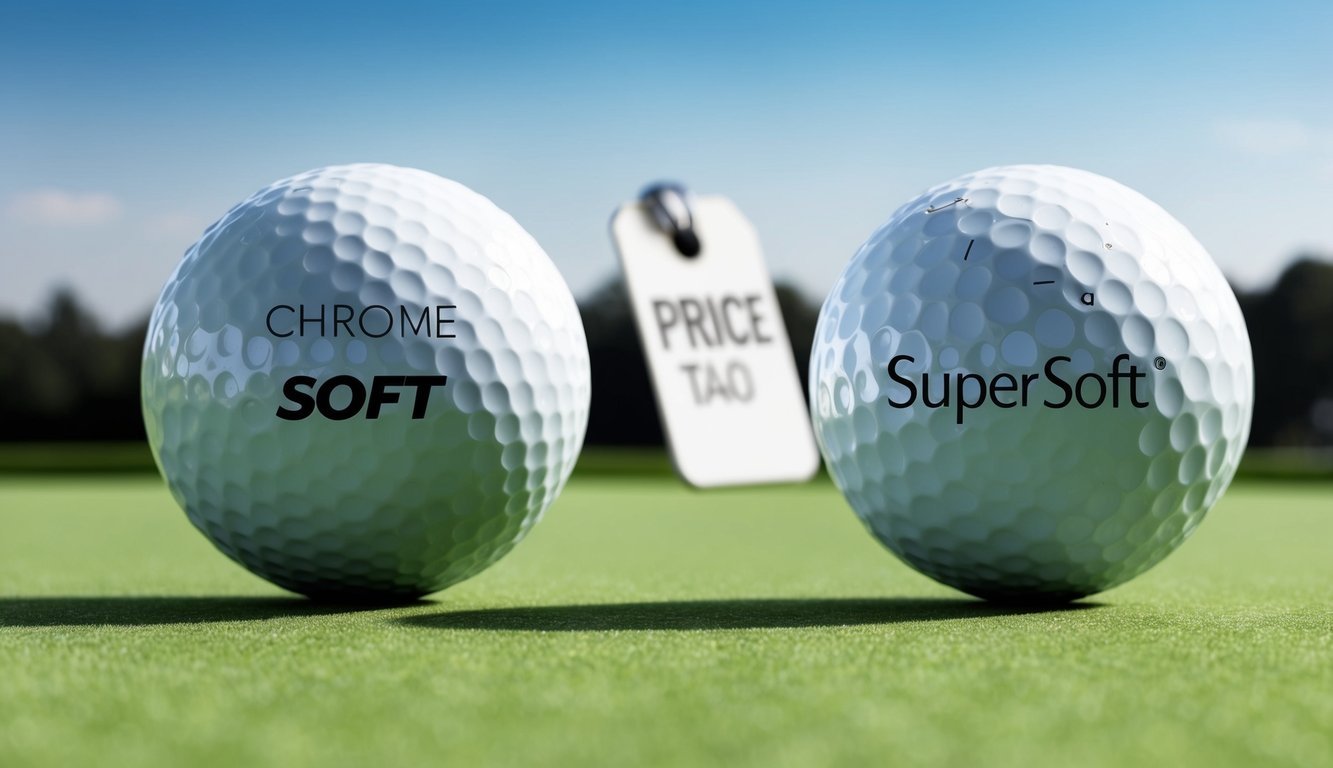Golf enthusiasts often seek ways to elevate their game, and the choice of golf ball plays a crucial role in performance.
When comparing Callaway’s Chrome Soft and Supersoft, each offers unique benefits tailored to specific playing styles.
The Chrome Soft is an excellent choice if you’re someone who values control and distance with a soft feel.
Meanwhile, the Supersoft is ideal for slower swing speeds, offering low spin and a straighter flight, making it particularly suited for high-handicappers.

Your decision may hinge on understanding what aspects of performance you prioritize.
The Chrome Soft is known for its combination of control, distance, and softness, particularly benefiting high-spin players seeking enhanced performance up and down the fairway.
On the other hand, the Supersoft, with its affordable two-piece construction, is crafted to optimize distance by producing lower spin on shots from the tee.
These Callaway golf balls showcase how advanced materials and technology can refine your golf experience.
Choosing between the Chrome Soft and Supersoft will depend on what you wish to achieve with your game.
With the right ball, you can make every swing count.
Key Takeaways
- Chrome Soft offers superior control and distance.
- Supersoft is great for slower swing speeds and high-handicappers.
- Consider technology and performance when selecting your ball.
Exploring the Brands: Callaway’s Place in Golf
When you think of premium golf equipment, Callaway inevitably comes to mind.
Known for their innovative designs and commitment to excellence, they are a leader in the golf industry.
Their golf balls, including the Callaway Chrome Soft and Callaway Supersoft, showcase their focus on delivering performance and quality.
Callaway’s reputation rests on years of producing top-tier golf balls.
The Chrome Soft is renowned for its ability to combine distance with control.
It’s an excellent choice if you prioritize greenside spin and feel.
On the other hand, the Supersoft offers a different experience, focusing on a softer feel and greater forgiveness.
Both of these balls can elevate your game in unique ways.
The Callaway Chrome Soft features a urethane cover that aids in providing precise control around the greens.
Meanwhile, the Callaway Supersoft utilizes a soft trionomer cover, enhancing its playability for those who prefer a softer touch.
Callaway doesn’t stop at just golf balls.
Their extensive range of golf equipment includes clubs, apparel, and accessories.
They are constantly pushing boundaries, striving to give you the tools to excel.
Callaway’s dedication to quality is evident in every product, ensuring you have the confidence to tackle any course.
The Core Differences: Chrome Soft vs SuperSoft

When comparing the Callaway Chrome Soft and SuperSoft golf balls, it’s essential to focus on their construction, compression rating, and spin characteristics.
These factors significantly influence how the ball performs both off the tee and around the greens.
Construction and Layers
The Chrome Soft and SuperSoft golf balls differ notably in their construction.
The Chrome Soft features a multi-layer construction, including a urethane cover, which enhances both durability and feel.
This cover is prized for promoting better control on approach shots.
In contrast, the SuperSoft is composed of two layers and utilizes an ionomer cover, specifically a surlyn outer layer.
This design prioritizes distance over durability, offering a softer overall feel for players with slower swing speeds.
The two-layer build of the SuperSoft aims to maximize distance while maintaining a low spin.
Compression Rating and Feel
Compression plays a vital role in how a golf ball feels upon impact and how it performs.
The SuperSoft has a noticeably lower compression rating of 38.
This low compression level is ideal for golfers seeking a softer touch and those whose swing speeds are slower.
The soft feel assists in achieving greater distances without needing to exert additional power.
On the other hand, the Chrome Soft has a higher compression rating, which offers a firmer feel.
This makes it more suitable for individuals with faster swing speeds.
The firmer feel helps generate more power at impact, providing better overall distance with controlled spin.
Spin and Control Characteristics
Spin greatly influences how a golf ball behaves in the air and how it reacts on the green.
The Chrome Soft is engineered for high spin on approaches, aiding in holding greens and providing players with tour-like control.
Meanwhile, the SuperSoft is designed for low spin from the tee, which helps in achieving longer rolls and more distance.
This characteristic is beneficial for players seeking maximum distance with each drive, although it may sacrifice some level of precision in green-side control compared to the Chrome Soft.
Understanding these spin differences is key to choosing the right ball to suit your game.
Performance on the Course: What to Expect
When comparing Callaway Chrome Soft and Supersoft, you will notice differences in aspects like distance, control, and durability.
Each ball caters to unique playing styles and preferences, impacting your overall performance from tee to green and in the short game.
Tee to Green Performance
The Callaway Chrome Soft golf balls feature a multi-layer construction designed to enhance performance across your long game.
With a premium four-piece design, these balls deliver higher ball speed and a soft feel, suitable for players with faster swing speeds.
If you’re looking to enhance your distance and control, the Chrome Soft might suit your needs.
In contrast, the Callaway Supersoft focuses on achieving lower spin rates, making it forgiving and reliable.
Its two-piece design is ideal for players with moderate swing speeds who want greater launch and distance but with less control compared to more advanced options.
Short Game Mastery
Around the greens, both balls excel in specific areas.
The Chrome Soft offers increased wedge spin and control, ideal for skilled golfers who need precision.
This control comes from its advanced cover, allowing you to shape your shots and achieve desirable results.
The Supersoft golf ball appeals to those prioritizing consistency and ease.
Its hybrid cover aids in providing a more straightforward experience in the short game, promoting a softer feel that can improve your touch when putting or approaching the greens.
This makes it an attractive option for recreational players.
Durability and Longevity
Golf ball durability is crucial for maintaining a consistent game.
The Chrome Soft features robust construction, ensuring longer-lasting durability, contributing to its premium status.
With its high-quality materials, you can expect sustained performance throughout multiple rounds.
On the other hand, the Supersoft might sacrifice a bit in terms of longevity due to its softer design.
The trade-off is in favor of more feel and distance, which can be advantageous for casual golfers who prefer a more affordable option while still benefiting from modern performance features.
Technological Innovations and Material Choices

In the world of golf balls, the Callaway Chrome Soft and Supersoft present unique technological features and material compositions.
You will discover how the choice of cover materials and core advancements can distinctly impact performance attributes like spin, feel, and distance.
Urethane vs Surlyn Covers
The choice between urethane and surlyn covers notably impacts performance.
The Callaway Chrome Soft features a urethane cover, known for its soft feel and control.
This material is often favored by those aiming for precision, especially around the greens.
Urethane tends to provide better spin for accomplished golfers, offering a higher level of control and finesse when compared to other materials.
On the other hand, the Supersoft uses a surlyn cover, sometimes referred to by its brand name, Trionomer, which contributes to its durability and reduced spin characteristics.
Surlyn’s toughness stands up well under regular play conditions, contributing to the ball’s overall lifespan.
While not as soft as urethane, it caters to players seeking long straight shots with minimal spin from the tee.
This makes it a good match for those with slower swing speeds.
Advancements in Core Technology
Core technology plays a pivotal role in differentiating these golf balls.
The Chrome Soft includes a graphene-infused SoftFast Core, promoting both forgiving feel and exceptional distance.
The core’s low compression level allows for increased ball speed, which may appeal to golfers wanting a combination of distance and feel.
The Supersoft, with its lower compression rating of 38, utilizes its ionomer layer to deliver long and smooth flights.
Employing HEX Aerodynamics, it enhances lift while minimizing drag, resulting in longer, straighter shots.
This core technology aligns well with players who might prefer enhancing their distance without sacrificing additional speed-related features.
Cost Considerations: Value for Money

When you’re considering which golf ball to purchase, price plays a crucial role.
Callaway’s Chrome Soft stands out as a premium option, often priced higher than its counterpart, the Supersoft.
This difference in cost reflects the advanced technology and materials used in premium golf balls, offering enhanced feel and performance for serious players.
For those on a budget, the Supersoft offers a more affordable choice.
Despite being cheaper, it delivers solid performance, making it a popular option among golfers seeking good value for money.
Its lower price does not necessarily mean lower quality, especially for players with slower swing speeds who benefit from its design.
Here’s a quick comparison:
| Golf Ball | Price Range | Category |
|---|---|---|
| Chrome Soft | More expensive | Premium ball |
| Supersoft | Cheaper and affordable | Budget option |
Choosing between these two comes down to what you value most—performance or cost-effectiveness.
If a premium golf ball is what you’re after, the investment in Chrome Soft might be worth it.
However, if you’re seeking value without a hefty price tag, the Supersoft is a noteworthy contender for providing reliability at a lower cost.
Choosing the Right Ball for Your Game

Choosing the perfect golf ball involves considering your swing speed, the feel you prefer, and how the ball performs compared to others on the market.
Understanding these aspects can significantly impact your game.
Matching Ball to Swing Speed
Your swing speed plays a crucial role in selecting the right golf ball.
If you have a slower swing speed, the Callaway Supersoft might be an excellent choice due to its low compression.
This ball helps achieve greater distance with less effort, offering a soft feel and straighter flight.
For those with higher swing speeds, the Callaway Chrome Soft could provide better results with its three-piece construction and precision enhancement.
Tour balls like the Titleist Pro V1 cater to players seeking maximum distance and pinpoint accuracy through greenside spin and tour-like performance.
Prioritizing Feel or Distance
Deciding between feel and distance can be a game-changer.
If you prioritize a soft feel and greenside spin, then the Chrome Soft offers a nice balance of both.
This makes it suitable for players who desire enhanced control on the greens.
On the other hand, the Supersoft excels in offering maximum distance for high handicappers, thanks to its soft compression core.
This is advantageous for those seeking increased yards off the tee.
In contrast, balls like the Callaway Superhot are specifically engineered for straightforward distance, providing a different experience depending on your performance needs.
Comparison to Market Competitors
When you compare these Callaway balls with market leaders, you’ll notice differences in performance features.
The Chrome Soft competes strongly with the Titleist Pro V1 regarding precision and spin.
Meanwhile, it offers a more budget-friendly option.
As for the Supersoft, its low compression compares favorably against other distance balls, aiding in achieving a straighter flight.
Many golfers find it particularly beneficial due to its affordability and ease of play, making it a popular choice among amateurs.
Each player’s choice depends on personal preferences and priorities, whether it be maximum accuracy or simply greater yardage.

